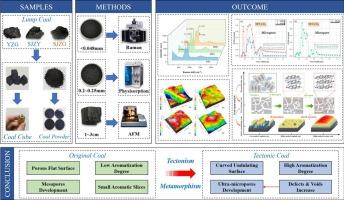Scale-span feature of surface analysis, macromolecular and pore structure in coal: Implications for inherent evolutionary mechanism of morphological microstructure
IF 4.5
2区 工程技术
Q2 ENGINEERING, CHEMICAL
引用次数: 0
Abstract
Morphological microstructural evolution of tectonic coal determines CBM storage and transportation mechanism as well as the occurrence of coal and gas outburst. Scale-span morphological feature of original and tectonic coals was characterized by AFM, Raman spectrum and physisorption method. The results demonstrate that metamorphism could remold the surface property of coal from rugged band to flat porous structure with pore form factor from 0.572 to 0.831, promoting the formation of regular and round pores. Tectonism facilitates ability of gas sorption in coal, breaking the basic structural integrity. Metamorphism could facilitate the ordered macromolecular structural evolution on recombination and aromatization as well as condensation; besides, tectonism may promote the evolution and development of microcrystalline structure in advance. The aforementioned results have revealed essential differences in morphological microstructure between original and tectonic coals, which are of great guiding significance to safe mining of CBM and prediction of coal and gas outburst.

煤的表面分析、大分子和孔隙结构的尺度跨度特征:形态微结构内在演化机制的含义
构造煤的形态微结构演化决定了煤层气的储运机制以及煤与瓦斯爆发的发生。通过原子力显微镜、拉曼光谱和物理吸附法对原煤和构造煤的尺度跨度形态特征进行了表征。结果表明,变质作用可重塑煤的表面性质,使其从凹凸不平的带状结构变为扁平的多孔结构,孔隙形式因子从 0.572 到 0.831,促进了规则圆形孔隙的形成。构造作用促进了煤的气体吸附能力,打破了基本结构的完整性。变质作用可促进大分子结构在重组、芳香化和缩聚过程中的有序演化;此外,构造作用可促进微晶结构的提前演化和发展。上述结果揭示了原生煤与构造煤形态微结构的本质区别,对煤层气安全开采和煤与瓦斯突出预测具有重要指导意义。
本文章由计算机程序翻译,如有差异,请以英文原文为准。
求助全文
约1分钟内获得全文
求助全文
来源期刊

Powder Technology
工程技术-工程:化工
CiteScore
9.90
自引率
15.40%
发文量
1047
审稿时长
46 days
期刊介绍:
Powder Technology is an International Journal on the Science and Technology of Wet and Dry Particulate Systems. Powder Technology publishes papers on all aspects of the formation of particles and their characterisation and on the study of systems containing particulate solids. No limitation is imposed on the size of the particles, which may range from nanometre scale, as in pigments or aerosols, to that of mined or quarried materials. The following list of topics is not intended to be comprehensive, but rather to indicate typical subjects which fall within the scope of the journal's interests:
Formation and synthesis of particles by precipitation and other methods.
Modification of particles by agglomeration, coating, comminution and attrition.
Characterisation of the size, shape, surface area, pore structure and strength of particles and agglomerates (including the origins and effects of inter particle forces).
Packing, failure, flow and permeability of assemblies of particles.
Particle-particle interactions and suspension rheology.
Handling and processing operations such as slurry flow, fluidization, pneumatic conveying.
Interactions between particles and their environment, including delivery of particulate products to the body.
Applications of particle technology in production of pharmaceuticals, chemicals, foods, pigments, structural, and functional materials and in environmental and energy related matters.
For materials-oriented contributions we are looking for articles revealing the effect of particle/powder characteristics (size, morphology and composition, in that order) on material performance or functionality and, ideally, comparison to any industrial standard.
 求助内容:
求助内容: 应助结果提醒方式:
应助结果提醒方式:


